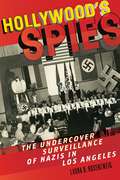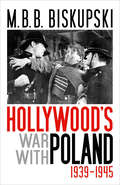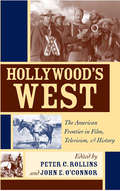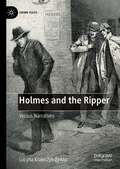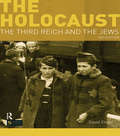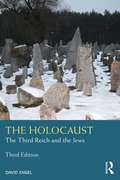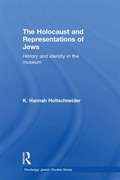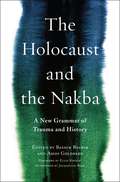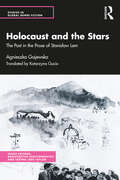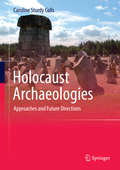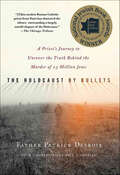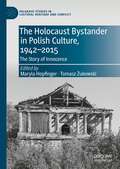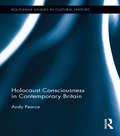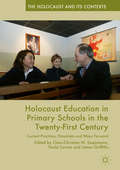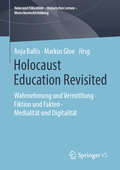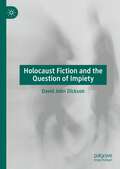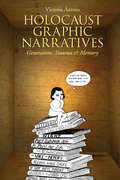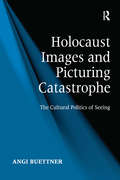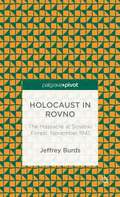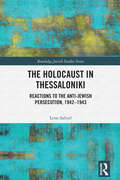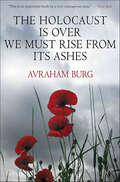- Table View
- List View
Hollywood's Italian American Filmmakers: Capra, Scorsese, Savoca, Coppola, and Tarantino
by Jonathan J. CavalleroHollywood's Italian American Filmmakers explores the different ways in which Italian American directors from the 1920s to the present have responded to their ethnicity. While some directors have used film to declare their ethnic roots and create an Italian American "imagined community," others have ignored or even denied their background. Jonathan J. Cavallero examines the films of Frank Capra, Martin Scorsese, Nancy Savoca, Francis Ford Coppola, and Quentin Tarantino with a focus on what the films reveal about each director's view on Italian American identities. Whereas Capra's films highlight similarities between immigrant characters and WASP Americans, Scorsese accepts his ethnic heritage but also sees it as confining. Similarly, many of Coppola's films provide a nostalgic treatment of Italian American identity, but with little criticism of the culture's more negative aspects. And while Savoca's movies reveal her artful ability to recognize how ethnic, gender, and class identities overlap, Tarantino's films exhibit a playfully postmodern engagement with Italian American ethnicity. Cavallero's exploration of the films of Capra, Scorsese, Savoca, Coppola, and Tarantino demonstrates how immigrant Italians fought prejudice, how later generations positioned themselves in relation to their predecessors, and how the American cinema, usually seen as a cultural institution that works to assimilate, has also served as a forum where assimilation was resisted.
Hollywood’s Spies: The Undercover Surveillance of Nazis in Los Angeles (Goldstein-Goren Series in American Jewish History #11)
by Laura B RosenzweigThe remarkable story of the Jewish moguls in Hollywood who established the first anti-Nazi Jewish resistance organization in the country in the 1930s.Finalist, Celebrate 350 Award in American Jewish Studies The 1939 film Confessions of a Nazi Spy may have been the first cinematic shot fired by Hollywood against Nazis in America, but it by no means marked the political awakening of the film industry&’s Jewish executives to the problem. Hollywood&’s Spies tells the remarkable story of the Jewish moguls in Hollywood who paid private investigators to infiltrate Nazi groups operating in Los Angeles, establishing the first anti-Nazi Jewish resistance organization in the country—the Los Angeles Jewish Community Committee (LAJCC). Drawing on more than 15,000 pages of archival documents, Laura B. Rosenzweig offers a compelling narrative illuminating the role that Jewish Americans played in combating insurgent Nazism in the United States in the 1930s. Forced undercover by the anti-Semitic climate of the decade, the LAJCC partnered with organizations whose Americanism was unimpeachable, such as the American Legion, to channel information regarding seditious Nazi plots to Congress, the Justice Department, the FBI and the Los Angeles Police Department.Hollywood&’s Spies corrects the decades-long belief that American Jews lacked the political organization and leadership to assert their political interests during this period in our history and reveals that the LAJCC was one of many covert &“fact finding&” operations funded by Jewish Americans designed to root out Nazism in the United States. &“A remarkable tale.&” —The Wall Street Journal &“Expose[s] a buried story about underground plots waged by Nazis against major Hollywood figures.&” —Los Angeles Review of Books
Hollywood's War with Poland, 1939–1945
by M.B.B. Biskupski&“This passionate, carefully researched, richly detailed, well-written study&” reveals the political motives behind WWII Hollywood&’s portrayal of Poles (Choice). During World War II, Hollywood studios supported the war effort by making patriotic movies designed to raise the nation's morale. Often the characterizations were as black and white as the movies themselves: Americans and their allies were heroes, while everyone else was a villain. The peoples of Norway, France, Czechoslovakia, and England were all good because they had been invaded or victimized by Nazi Germany. Yet Poland—the first country to be invaded by the Third Reich—was repeatedly represented in a negative light. In this prize-winning study, Polish historian M. B. B. Biskupski explores why. Biskupski presents a close critical study of prewar and wartime films such as To Be or Not to Be, In Our Time, and None Shall Escape. Through memoirs, letters, diaries, and memoranda written by screenwriters, directors, studio heads, and actors, Biskupski examines how the political climate, and especially pro-Soviet sentiment, influenced Hollywood films of the time. Winner of the Oscar Halecki PrizeA Choice Outstanding Academic Title
Hollywood's West: The American Frontier in Film, Television, & History
by Peter C. Rollins and John E. O’Connor&“An excellent study that should interest film buffs, academics, and non-academics alike&” (Journal of the West). Hollywood&’s West examines popular perceptions of the frontier as a defining feature of American identity and history. Seventeen essays by prominent film scholars illuminate the allure of life on the edge of civilization and analyze how this region has been represented on big and small screens. Differing characterizations of the frontier in modern popular culture reveal numerous truths about American consciousness and provide insights into many classic Western films and television programs, from RKO&’s 1931 classic Cimarron to Turner Network Television&’s recent made-for-TV movies. Covering topics such as the portrayal of race, women, myth, and nostalgia, Hollywood&’s West makes a significant contribution to the understanding of how Westerns have shaped our nation&’s opinions and beliefs—often using the frontier as metaphor for contemporary issues.
Hollywood's White House: The American Presidency in Film and History
by Peter C. Rollins and John E. O’ConnorFrom action flicks to biopics to SNL skits, how presidents are portrayed on screen: &“An interesting study of the real presidency and the reel presidency.&” —USA Today Magazine Winner of the Popular Culture Association&’s Ray and Pat Browne Book Award Whether serious or satirical, biographical or fictional, the ways that US presidents are depicted in popular culture reveal much about us as a nation. The contributors to Hollywood&’s White House examine the historical accuracy of presidential depictions, illuminate their influence, and uncover how they reflect the concerns of their times and the social and political visions of the filmmakers. With reflections on portrayals of Washington, Adams, Lincoln, FDR, Nixon, and more, this volume, which includes a comprehensive filmography and a bibliography, is ideal for both historians and film enthusiasts. &“An engaging collection.&” —Robert Brent Toplin, author of Reel History: In Defense of Hollywood
Holmes and the Ripper: Versus Narratives (Crime Files)
by Lucyna Krawczyk-ŻywkoIn versus narratives Sherlock Holmes is fighting or otherwise engaging Jack the Ripper. These texts pit the archetypal detective against the archetypal serial killer using established formulas as well as new narrative and generic features, a combination that results in their mass appeal among authors and audiences alike. The list of primary sources includes 120 titles – novels, short stories, plays, fanfiction, ‘Grand Game’ studies, movies, TV shows, video and board games – which are treated as a dialogic network of transfictional and transmedial texts. This study unpacks the versus corpus in its media dispersal by analysing Sherlock Holmes and Jack the Ripper as serial figures and culture-texts emphasising the increasing palimpsestousness of the former and the multidirectional polymorphousness of the latter, and tracing the overlapping Doylean culture-text. It also addresses the way character constellations are represented, negotiated, and fed back into the versus network, contextualising them within the coalescence of fact and fiction, Gothic and crime fiction frames, cultural memory, neo-Victorianism, and biofiction.
The Holocaust: The Third Reich and the Jews
by David EngelFully revised and updated, this second edition includes: · A much expanded selection of original documents, many never before anthologised in English · Added treatment of the role of non-Germans in the Holocaust and the geographical variations in Jewish response · Additional consideration of the much-debated nexus between the Holocaust and modernity · A new section on how 'the Holocaust' developed as a distinct historical topic · Useful and informative Chronology, Who’s Who and Glossary David Engel’s book is a taut, compact narration that appeals to the intellect as much, if not more, than to the emotions. It is sure to be welcomed by students in departments of History, Politics and European Studies as well as by anyone trying to get to grips with this complex and far-reaching subject for the first time.
The Holocaust: The Third Reich and the Jews (Seminar Studies)
by David EngelThis book offers a survey of the encounter between the Third Reich and European Jewry. Pointing out the difficulties historians face in interpreting the ever-expanding documentary record, it includes treatment of the role of non-Germans in the Holocaust, consideration of the much-debated nexus between the Holocaust and modernity, and discussion on how 'the Holocaust' developed as a distinct historical topic. Fully updated, this new third edition incorporates the latest scholarly findings with expanded treatment of gendered aspects of the Holocaust, the Holocaust’s world historical contexts, the long-term history of Jewish-Christian relations, and thinking about the Holocaust’s contemporary relevance, as well as additional documents reflecting recent archival discoveries. Offering a concise narration that appeals to both the intellect and the emotions, the book enables students to gain a real understanding of the events of this catastrophic time. Including a useful selection of original documents (many never before anthologised in English), a chronology, glossary, and 'who’s who', David Engel’s book will be welcomed by anyone trying to get to grips with this complex and far-reaching subject.
Holocaust: An American Understanding
by Deborah E. LipstadtImmediately after World War II, there was little discussion of the Holocaust, but today the word has grown into a potent political and moral symbol, recognized by all. In Holocaust: An American Understanding, renowned historian Deborah E. Lipstadt explores this striking evolution in Holocaust consciousness, revealing how a broad array of Americans--from students in middle schools to presidents of the United States--tried to make sense of this inexplicable disaster, and how they came to use the Holocaust as a lens to interpret their own history. Lipstadt weaves a powerful narrative that touches on events as varied as the civil rights movement, Vietnam, Stonewall, and the women's movement, as well as controversies over Bitburg, the Rwandan genocide, and the bombing of Kosovo. Drawing upon extensive research on politics, popular culture, student protests, religious debates and various strains of Zionist ideologies, Lipstadt traces how the Holocaust became integral to the fabric of American life. Even popular culture, including such films as Dr. Strangelove and such books as John Hershey's The Wall, was influenced by and in turn influenced thinking about the Holocaust. Equally important, the book shows how Americans used the Holocaust to make sense of what was happening in the United States. Many Americans saw the civil rights movement in light of Nazi oppression, for example, while others feared that American soldiers in Vietnam were destroying a people identified by the government as the enemy. Lipstadt demonstrates that the Holocaust became not just a tragedy to be understood but also a tool for interpreting America and its place in the world. Ultimately Holocaust: An American Understanding tells us as much about America in the years since the end of World War II as it does about the Holocaust itself.
The Holocaust and Representations of Jews: History and Identity in the Museum (Routledge Jewish Studies Series)
by K. Hannah HoltschneiderThe Holocaust and Representations of Jews examines how prominent national exhibitions in Europe represent the Jewish minority and its cultural and religious self-understandings, historically and today, in particular in the context of the Holocaust. Insights from the New Museology are brought to the field of Jewish Studies through an exploration of the visual representation of Jewish history and Jewish identifications in the display of photographs. Drawing on case studies which focus on the Holocaust Exhibition at the Imperial War Museum in London and the permanent exhibition at the Jewish Museum Berlin, these themes become the prism through which aspects of historiography and the display of the ‘otherness’ of minorities are addressed. Casting new light on the issues surrounding the visual representation of Jews, the work of museum practitioners in relation to historical presentations and to the use of photographs in exhibitions, this book is an important contribution not only to the fields of Jewish Studies, Religion and History, but also to the study of the representation of minority-majority relations and the understanding of exhibition visits as an educational tool.
The Holocaust and the Nakba: A New Grammar of Trauma and History (Religion, Culture, and Public Life #39)
by Jacqueline Rose Omer Bartov Gil Anidjar Alon Confino Yehouda Shenhav Mark Levene Hannan Hever Refqa Abu-Remaileh Omri Ben-Yehuda Tal Ben-Zvi Yochi Fischer Honaida Ghanim Mustafa Kabha Nadim Khoury Amnon Raz-Krakotzkin Raef ZreikIn this groundbreaking book, leading Arab and Jewish intellectuals examine how and why the Holocaust and the Nakba are interlinked without blurring fundamental differences between them. While these two foundational tragedies are often discussed separately and in abstraction from the constitutive historical global contexts of nationalism and colonialism, The Holocaust and the Nakba explores the historical, political, and cultural intersections between them. The majority of the contributors argue that these intersections are embedded in cultural imaginations, colonial and asymmetrical power relations, realities, and structures. Focusing on them paves the way for a new political, historical, and moral grammar that enables a joint Arab-Jewish dwelling and supports historical reconciliation in Israel/Palestine.This book does not seek to draw a parallel or comparison between the Holocaust and Nakba or to merely inaugurate a “dialogue” between them. Instead, it searches for a new historical and political grammar for relating and narrating their complicated intersections. The book features prominent international contributors, including a foreword by Lebanese novelist Elias Khoury on the centrality of the Holocaust and Nakba in the essential struggle of humanity against racism, and an afterword by literary scholar Jacqueline Rose on the challenges and contributions of the linkage between the Holocaust and Nakba for power to shift and a world of justice and equality to be created between the two peoples. The Holocaust and the Nakba is the first extended and collective scholarly treatment in English of these two constitutive traumas together.
Holocaust and the Stars: The Past in the Prose of Stanisław Lem (Studies in Global Genre Fiction)
by Agnieszka GajewskaThis book is a groundbreaking study of one of the greatest science fiction writers, the Polish master Stanisław Lem. It offers a new direction in research on his oeuvre and corrects several errors commonly appearing in his biographies. The author painstakingly recreates the context of Lem’s early life and his traumatic experiences during the Second World War due to his Jewish background, and then traces these through original and brilliant readings of his fiction and non-fiction. She considers language, worldbuilding, themes, motifs and characterization as well as many buried allusions to the Holocaust in Lem’s published and archival work, and uses these fragments to capture a different side of Lem than previously known. The book discusses various issues concerning the writer’s life, such as his upbringing in a Jewish, Zionist-minded family, the extensive relations between the Lem family and the elite of Lviv at that time, details of the Lem family killed during the German occupation and attempts to reconstruct what happened to Lem’s parents and to the writer himself after escaping the ghetto. Part of the Studies in Global Genre Fiction series, this English translation of the Polish original, which has already been considered a milestone in Lem studies, offers a fresh perspective on the writer and his work. It will be an important intervention for scholars and researchers of Jewish studies, Holocaust literature, science fiction studies, English literature, world war studies, minority studies, popular culture, history and cultural studies.
Holocaust Archaeologies
by Caroline Sturdy CollsHolocaust Archaeologies: Approaches and Future Directions aims to move archaeological research concerning the Holocaust forward through a discussion of the variety of the political, social, ethical and religious issues that surround investigations of this period and by considering how to address them. It considers the various reasons why archaeological investigations may take place and what issues will be brought to bear when fieldwork is suggested. It presents an interdisciplinary methodology in order to demonstrate how archaeology can (uniquely) contribute to the history of this period. Case examples are used throughout the book in order to contextualise prevalent themes and a variety of geographically and typologically diverse sites throughout Europe are discussed. This book challenges many of the widely held perceptions concerning the Holocaust, including the idea that it was solely an Eastern European phenomena centred on Auschwitz and the belief that other sites connected to it were largely destroyed or are well-known. The typologically , temporally and spatial diverse body of physical evidence pertaining to this period is presented and future possibilities for investigation of it are discussed. Finally, the volume concludes by discussing issues relating to the "re-presentation" of the Holocaust and the impact of this on commemoration, heritage management and education. This discussion is a timely one as we enter an age without survivors and questions are raised about how to educate future generations about these events in their absence.
The Holocaust by Bullets: A Priest's Journey to Uncover the Truth Behind the Murder of 1.5 Million Jews
by Patrick DesboisWinner of the National Jewish Book Award: The story of how a Catholic priest uncovered the truth behind the murder of more than a million Ukrainian Jews.Father Patrick Desbois documents the daunting task of identifying and examining all the sites where Jews were exterminated by Nazi mobile units in Ukraine in WWII. Using innovative methodology, interviews, and ballistic evidence, he has determined the location of many mass gravesites with the goal of providing proper burials for the victims of the forgotten Ukrainian Holocaust.Compiling new archival material and many eye-witness accounts, Desbois has put together the first definitive account of one of World War II’s bloodiest chapters. Published with the support of the United States Holocaust Memorial Museum.“This modest Roman Catholic priest from Paris, without using much more than his calm voice and Roman collar, has shattered the silence surrounding a largely untold chapter of the Holocaust.” —Chicago Tribune“Part memoir, part prosecutorial brief, The Holocaust by Bullets tells a compelling story in which a priest unconnected by heritage or history is so moved by an injustice he sets out to right a daunting wrong.” —The Miami Herald“Father Desbois is a generation too late to save lives. Instead, he has saved memory and history.” —The Wall Street Journal“An outstanding contribution to Holocaust literature, uncovering new dimensions of the tragedy . . . Highly recommended.” —Library Journal (starred review)
The Holocaust Bystander in Polish Culture, 1942-2015: The Story of Innocence (Palgrave Studies in Cultural Heritage and Conflict)
by Maryla Hopfinger Tomasz ŻukowskiThis book concerns building an idealized image of the society in which the Holocaust occurred. It inspects the category of the bystander (in Polish culture closely related to the witness), since the war recognized as the axis of self-presentation and majority politics of memory. The category is of performative character since it defines the roles of event participants, assumes passivity of the non-Jewish environment, and alienates the exterminated, thus making it impossible to speak about the bystanders’ violence at the border between the ghetto and the ‘Aryan’ side. Bystanders were neither passive nor distanced; rather, they participated and played important roles in Nazi plans. Starting with the war, the authors analyze the functions of this category in the Polish discourse of memory through following its changing forms and showing links with social practices organizing the collective memory. Despite being often critiqued, this point of dispute about Polish memory rarely belongs to mainstream culture. It also blocks the memory of Polish violence against Jews. The book is intended for students and researchers interested in memory studies, the history of the Holocaust, the memory of genocide, and the war and postwar cultures of Poland and Eastern Europe.
Holocaust Consciousness in Contemporary Britain (Routledge Studies in Cultural History #27)
by Andy PearceThe Holocaust is a pervasive presence in British culture and society. Schools have been legally required to deliver Holocaust education, the government helps to fund student visits to Auschwitz, the Imperial War Museum's permanent Holocaust Exhibition has attracted millions of visitors, and Britain has an annually commemorated Holocaust Memorial Day. What has prompted this development, how has it unfolded, and why has it happened now? How does it relate to Britain's post-war history, its contemporary concerns, and the wider "globalisation" of Holocaust memory? What are the multiple shapes that British Holocaust consciousness assumes and the consequences of their rapid emergence? Why have the so-called "lessons" of the Holocaust enjoyed such popularity in Britain? Through analysis of changing engagements with the Holocaust in political, cultural and memorial landscapes over the past generation, this book addresses these questions, demonstrating the complexities of Holocaust consciousness and reflecting on the contrasting ways that history is used in Britain today.
Holocaust Education in Primary Schools in the Twenty-First Century: Current Practices, Potentials and Ways Forward (The Holocaust and its Contexts)
by Claus-Christian W. Szejnmann Paula Cowan James GriffithsThis collection is the first of its kind, bringing together Holocaust educational researchers as well as school and museum educators from across the globe, to discuss the potentials of Holocaust education in relation to primary school children. Its contributors are from countries that have a unique relationship with the Holocaust, such as Germany, Israel, neutral Switzerland, and Allied countries outside the UK. Their research provides new insight into the diverse ways in which primary aged students engage with Holocaust education. Chapters explore the impact of teaching the Holocaust to this age group, school and museum teaching pedagogies, and primary students’ perspectives of the Holocaust. This book will appeal to school and museum educators of primary aged students whose work requires them to teach the Holocaust, Citizenship (or Civics) or Human Rights Education. Since the turn of the twenty-first century there has been a transformation in school and museum-based Holocaust education. This book clearly demonstrates that primary education has been included in this transformation.
Holocaust Education Revisited: Wahrnehmung und Vermittlung • Fiktion und Fakten • Medialität und Digitalität (Holocaust Education – Historisches Lernen – Menschenrechtsbildung)
by Anja Ballis Markus GloeDer Band wendet sich Konzepten von „Holocaust Education“ zu, die auf einer Tagung an der LMU München im Februar 2018 diskutiert worden sind: Wissenschaftlerinnen und Wissenschaftler verschiedener Disziplinen reflektierten über Zieldimensionen, mediale Repräsentationen sowie Wandel und Herausforderungen bei der Vermittlung der Themenfelder Holocaust und NS-Verbrechen. Die kritische Auseinandersetzung mit Konzepten von „Holocaust Education“ hat sich auch im 21. Jahrhundert als produktiv erwiesen: Es kann ein vielstimmiger und auf die Gegenwart bezogener Diskurs entfaltet werden, der von Fragen der Vermittlung im Klassenzimmer bis zu der Virtualisierung von Zeugenschaft in Museen und daraus resultierender didaktischer Konsequenzen reicht. Der InhaltZur Einführung • Wahrnehmung und Vermittlung • Fiktionen und Fakten • Medialität und DigitalitätDie HerausgeberDr. Anja Ballis ist Professorin am Fachbereich Didaktik der deutschen Sprache und Literatur der Ludwig-Maximilians-Universität München.Dr. Markus Gloe ist Professor am Fachbereich Politische Bildung und Didaktik der Sozialkunde an der Ludwig-Maximilians-Universität München.
Holocaust Fiction and the Question of Impiety
by David John DicksonThis book discusses the issues underlying contemporary Holocaust fiction. Using Gillian Rose’s theory of Holocaust piety, it argues that, rather than enhancing our understanding of the Holocaust, contemporary fiction has instead become overly focused on gratuitous representations of bodies in pain. The book begins by discussing the locations and imagery which have come to define our understanding of the Holocaust, before then highlighting how this gradual simplification has led to an increasing sense of emotional distance from the historical past. Holocaust fiction, the book argues, attempts to close this emotional and temporal distance by creating an emotional connection to bodies in pain. Using different concepts relating to embodied experience – from Sonia Kruks’ notion of feeling-with to Alison Landsberg’s prosthetic memory – the book analyses several key examples of Holocaust literature and film to establish whether fiction still possesses the capacity to approach the Holocaust impiously.
Holocaust Graphic Narratives: Generation, Trauma, and Memory
by Victoria AaronsIn Holocaust Graphic Narratives, Victoria Aarons demonstrates the range and fluidity of this richly figured genre. Employing memory as her controlling trope, Aarons analyzes the work of the graphic novelists and illustrators, making clear how they extend the traumatic narrative of the Holocaust into the present and, in doing so, give voice to survival in the wake of unrecoverable loss. In recreating moments of traumatic rupture, dislocation, and disequilibrium, these graphic narratives contribute to the evolving field of Holocaust representation and establish a new canon of visual memory. The intergenerational dialogue established by Aarons’ reading of these narratives speaks to the on-going obligation to bear witness to the Holocaust. Examined together, these intergenerational works bridge the erosions created by time and distance. As a genre of witnessing, these graphic stories, in retracing the traumatic tracks of memory, inscribe the weight of history on generations that follow.
Holocaust Images and Picturing Catastrophe: The Cultural Politics of Seeing
by Angi BuettnerHolocaust Images and Picturing Catastrophe explores the phenomenon of Holocaust transfer, analysing the widespread practice of using the Holocaust and its imagery for the representation and recording of other historical events in various media sites. It investigates the use of Holocaust imagery in political and legal discourses, in critical thinking and philosophy, as well as in popular culture, to provide a fresh theorisation of the manner in which the Holocaust comes loose from its historical context and is applied to events and campaigns in the contemporary public sphere. Richly illustrated with concrete examples, including prominent, international animal rights activism, the Israeli-Palestinian conflict and the genocide in Rwanda, this book traces the visual rhetoric of Holocaust imagery and its application to events other than the genocide of Jewish people With its discussion of the wide range of issues arising with this form of 'Holocaust-transfer', the generalization of the Holocaust as a metaphor in representations of catastrophe, as well as in other cultural locations, Holocaust Images and Picturing Catastrophe will appeal to those working in the fields of holocaust studies, cultural and visual culture studies, sociology, and media studies.
The Holocaust In American Life
by Peter NovickThis “courageous and thought-provoking book” examines how the Holocaust came to hold its unique place in American memory (Foreign Affairs).Prize–winning historian Peter Novick explores in absorbing detail the decisions that moved the Holocaust to the center of American life. He illuminates how Jewish leaders invoked its memory to muster support for Israel, and how politicians in turn used it to score points with Jewish voters. With insight and sensitivity, Novick raises searching questions about these developments, their meaning, and their consequences. Does the Holocaust really teach useful lessons and sensitize us to atrocities, or, by making the Holocaust the measure, does it make lesser crimes seem “not so bad”? Have American Jews, by making the Holocaust the emblematic Jewish experience, given Hitler a posthumous victory, tacitly endorsing his definition of Jews as despised pariahs? What are we to make of the fact that while Americans spend hundreds of millions of dollars for museums recording a European crime, while comparatively little is done to memorialize American slavery?A New York Times Notable Book
Holocaust in Rovno: The Massacre at Sosenki Forest, November 1941
by Jeffrey BurdsIn November 1941, near the city of Rovno, Ukraine, German death squads murdered over 23,000 Jews in what has been described as the second Babi Yar. This meticulous and methodologically innovative study reconstructs the events at Rovno, and in the process exemplifies efforts to form a genuinely transnational history of the Holocaust.
The Holocaust in Thessaloniki: Reactions to the Anti-Jewish Persecution, 1942–1943 (Routledge Jewish Studies Series)
by Leon SaltielThe book narrates the last days of the once prominent Jewish community of Thessaloniki, the overwhelming majority of which was transported to the Nazi death camp of Auschwitz in 1943. Focusing on the Holocaust of the Jews of Thessaloniki, this book maps the reactions of the authorities, the Church and the civil society as events unfolded. In so doing, it seeks to answer the questions, did the Christian society of their hometown stand up to their defense and did they try to undermine or object to the Nazi orders? Utilizing new sources and interpretation schemes, this book will be a great contribution to the local efforts underway, seeking to reconcile Thessaloniki with its Jewish past and honour the victims of the Holocaust. The first study to examine why 95 percent of the Jews of Thessaloniki perished—one of the highest percentages in Europe—this book will appeal to students and scholars of the Holocaust, European History and Jewish Studies.
The Holocaust Is Over; We Must Rise From its Ashes
by Avraham BurgModern-day Israel, and the Jewish community, are strongly influenced by the memory and horrors of Hitler and the Holocaust. Burg argues that the Jewish nation has been traumatized and has lost the ability to trust itself, its neighbors or the world around it. He shows that this is one of the causes for the growing nationalism and violence that are plaguing Israeli society and reverberating through Jewish communities worldwide. Burg uses his own family history--his parents were Holocaust survivors--to inform his innovative views on what the Jewish people need to do to move on and eventually live in peace with their Arab neighbors and feel comfortable in the world at large. Thought-provoking, compelling, and original, this book is bound to spark a heated debate around the world.

